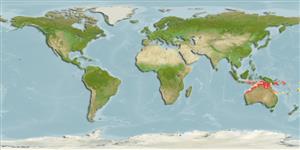Common names from other countries
>
Carangiformes (Jacks) >
Carangidae (Jacks and pompanos) > Caranginae
Etymology: Caranx: French, carangue, the name of a Caribbean fish; 1836 (Ref. 45335).
More on authors: Alleyne & Macleay.
Environment: milieu / climate zone / depth range / distribution range
экология
морской; солоноватоводный ассоциированный с рифами; пределы глубины 7 - 63 m. Tropical; 7°S - 23°S
Southwest Pacific: Arafura Sea (Ref. 9819), northern Australia, from the Timor Sea in the west (Ref. 6905) to the Gulf of Papua in the north (Ref. 6906) and on the eastern coast of Australia as far south as Gladstone (Ref. 6907).
Length at first maturity / Size / Вес / Возраст
Maturity: Lm ?, range 11 - ? cm
Max length : 66.0 cm TL самец/пол неопределен; (Ref. 2334)
Adults are common in prawn trawling grounds and are most abundant closer to the coast. They feed predominantly on benthic prey consisting mainly of crustaceans and teleosts (Ref. 6908). They exhibit diel vertical migration, possibly following the movement of crustaceans along the water column. Continuous spawning during the year (Ref. 6904). Juveniles are often encountered in estuaries. Caught mainly on hook-and-line and by spearing; also with gill nets and other artisanal gear. This species is an excellent sports fish (Ref. 9894).
Randall, J.E., G.R. Allen and R.C. Steene, 1990. Fishes of the Great Barrier Reef and Coral Sea. University of Hawaii Press, Honolulu, Hawaii. 506 p. (Ref. 2334)
Статус Красного Списка МСОП (Ref. 130435)
CITES (Ref. 128078)
Not Evaluated
Угроза для людей
Harmless
Использование человеком
рыболовство: не имеет хозяйственного значения; объект спортивного рыболовства: да
дополнительная информация
инструменты
Специальные отчеты
Скачать в формате XML
ресурсы в Интернет
Estimates based on models
Preferred temperature (Ref.
115969): 26.2 - 28.6, mean 27.7 (based on 326 cells).
Phylogenetic diversity index (Ref.
82804): PD
50 = 0.5000 [Uniqueness, from 0.5 = low to 2.0 = high].
Bayesian length-weight: a=0.02455 (0.01365 - 0.04414), b=2.92 (2.76 - 3.08), in cm Total Length, based on LWR estimates for this species & (Sub)family-body (Ref.
93245).
Trophic level (Ref.
69278): 3.8 ±0.0 se; based on diet studies.
устойчивость к внешним воздействиям (Ref.
120179): средний (среднего размера), минимальное время удвоения популяции 1.4-4.4 года (K=0.30; Fec: >8,000).
Fishing Vulnerability (Ref.
59153): Moderate vulnerability (36 of 100).
